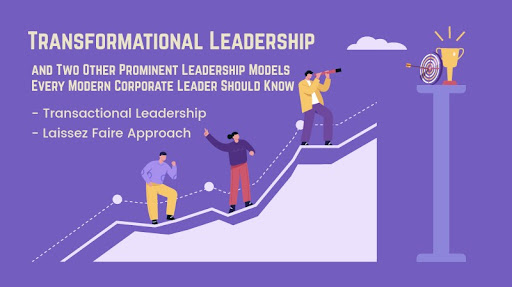Years and years of research and thought have led to the development of multiple leadership styles, such as the ones mentioned above – each with its merits and demerits. Such leadership styles have often been responses to the global business environment in which they were born.
In the 21st century, where disruption has become commonplace, organisations and leaders are keen to adopt transformational leadership characteristics as their model of choice in order to empower and encourage people to drive success. But why transformational leadership? And what is it that separates it from the other two popular models – transactional leadership and the laissez-faire approach?
Understanding Transformational Leaders: What is the Transformational Leadership Theory?
Transformational leadership is all about ‘transforming’ an organisation through the identification of challenges, developing a vision, and motivating and inspiring individuals to commit to a common purpose. Transformational leaders in the modern corporate world focus on building up the capacity of their teams strategically to equip them adequately for embracing disruption and change.
Transformational leaders can successfully motivate and stimulate their teams and employees to take ownership of their work, take calculated risks in pursuit of innovation, be creative with their ideas, and feel understood, appreciated, and well-supported. Such a leadership style is built upon the popular theory established by famous researchers and psychologists such as James V. Downton, James MacGregor, and Bernard M. Bass.
Transformational Leadership Style
The primary agenda for the transformational leadership style is to create an agile, flexible, and innovative business that is driven by future-ready professionals. This can be achieved by the following methods, as proposed by Bernard M. Bass in 1985:
- Idealised influence
- Intellectual stimulation
- Inspirational motivation
- Individual consideration
One of the best examples of transformational leadership models in play is how Sanjiv Bajaj – the Chairman and Managing Director of Bajaj Finserv and President of CII (2022-23) – has been able to transform Bajaj Finserv into India’s leading financial services provider. Often believed to be the best transformational leader in India in the finance sector, Sanjiv Bajaj has a clear principle: ‘think like owners’. This is what he has ingrained within his teams that can facilitate business growth by anticipating customer demands and challenges and innovating without limits. As a result, Bajaj Finserv is a frontrunner in developing new fintech services and products that are furthering India’s financial ‘atmanirbharta’ dream.
Let us take a closer look.
Another famous transformational leader is Sunil Bharti Mittal – the Founder, Chairman, and Group CEO of Bharti Enterprises, which owns Airtel. Well-versed in the principles of transformational change, Sunil Mittal is the man behind the successful disruption of the legacy telecom model in India. He turned Airtel into one of India’s most prominent mobile service providers, with over 190 million subscribers, by aligning organisational goals with employee aspirations. His 5P transformational leadership model focused on people, passion, performance, pride, and processes to bring unprecedented success to the business.
With more and more empowering leaders coming to the fore, what makes this style of leadership so apt for the modern business context? The answer lies in how business environments today are becoming increasingly volatile, uncertain, complex, and ambiguous (VUCA).Transformational leadership allows such entrepreneurs and leaders to keep pace with external change by fostering internal change, thus preparing their businesses to deal with future disruptions smoothly.
But what about transactional leadership and laissez-faire? Let us understand how they hold up to transformational leadership.
Comparing Transformational Leadership with Other Models
Transactional Leadership
Transactional leadership is all about developing a ‘transactional’ relationship between the leader and the employees to drive productivity. In this style of leadership, leaders use positive reinforcement through incentivisation of tasks and organisational goals in order to motivate the employee. Compared to transformational leadership, which is about inciting intrinsic motivation, transactional leadership is all about extrinsic motivation.
The straightforward nature of transactional leadership makes it quite practical to implement, especially when setting up an organisation. Transactional leaders can quicken the pace of productivity and establish processes and mechanisms within the organisation as they are all about efficiency. Another difference is that transactional leaders encourage employees to work according to a proven standard or process, whereas transformational leaders foster more creativity, innovation, and free-thinking among employees.
An excellent example of transactional leadership is how Bill Gates co-founded and built Microsoft into one of the world’s most influential and successful business entities. Bill Gates was able to inspire outcomes at the leading computer technology player simply by establishing structure and organisation and holding his employees to a high-performance standard. His systematic approach to leadership was to align his teams to successfully create barriers to new entrants in the market and control the production process to gain consumer trust.
Laissez Faire Approach
Due to its detached style, the laissez-faire method has often been touted as a ‘lack of leadership’. However, it is still a very successful leadership model that is built upon an attitude of trust and confidence in the abilities of employees. While transformational leaders are often found interacting and engaging with their employees in order to stimulate them, laissez-faire leaders believe in keeping to themselves and letting the workforce solve challenges and lead the company forward.
Laissez-faire leadership is all about taking the back seat and not micromanaging everything at one’s business. This interference-free nature of corporate leadership is great for creating a culture where employees can think creatively, utilise resources as they deem fit, and establish their path to charting company objectives. Knowing how to delegate is a chief skill of laissez-faire leaders, as placing one’s trust in the wrong people can spell disaster for business sustainability.
With a current net worth of $100 billion, Warren Buffett is one of the most successful entrepreneurs of our time. A role model investor for millions, Warren Buffet is best known for his ability to place trust in self-motivated, skilled individuals in his teams so that they can deliver as per expectations.
Final Thoughts
Many studies support the transformational leadership method since it fosters a supportive atmosphere. Such a business environment allows employees to thrive, work creatively, demonstrate dedication, and accomplish the desired outcomes. By aligning the commitment of individuals to the organisation’s vision, transformational leaders ensure that their teams are agile, flexible, and determined enough to overcome future disruptions.
However, that does not mean that other leadership styles, such as transactional leadership and laissez-faire approach, are redundant. In the right context and situation, these two styles can deliver the most efficient results. That is because of employee considerations and the way to motivate them to change according to the circumstances they find themselves in. Sometimes, leaders will do better to incentivise employees with a reward-based system, while other times, they would be better off letting employees take charge independently. The hallmark of a visionary leader, therefore, is to know which style of leadership to follow and when.




